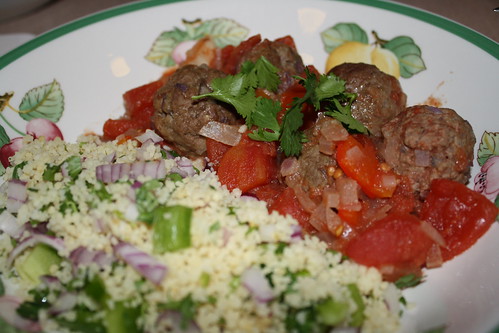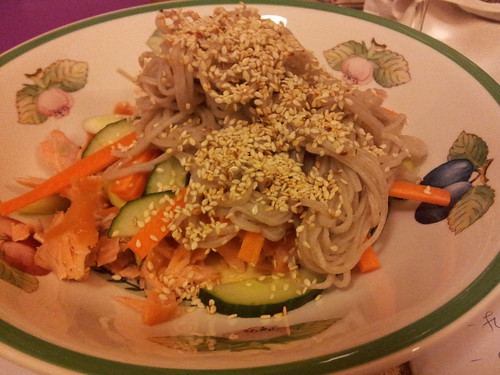I was just about to post a recipe for rocket pesto when I discovered that I’d done that way back in 2011. No point in telling you the same thing twice – and (depressingly) my more recent photo was actually worse too!
Fortunately, my back log of photos suggests that I write instead about some baked Moroccan meatballs that we had for an easy dinner before the latest lot of hot weather invaded.
If you can start this a little ahead, it’s worth it: allowing the meatballs some time to sit in the fridge, firm up and develop flavours is time well spent. But, if you’re in a rush – no matter, you can have this dinner on the table quickly.
This recipe should make enough meatballs for four for dinner.
Begin by taking 500g of lean beef mince. Mix in half a red onion, finely chopped, and a generous 2 tsp of ras el-hanout. If you don’t have that to hand, use some ground coriander and cumin. Add salt, pepper and additional chilli (use chilli powder for this, rather than flakes) to taste. Because my ras el-hanout had chilli in it, I just stuck to salt and pepper.
Ensure the seasoning and onion is mixed thoroughly through the mince, form into walnut sized meatballs, place on a plate and refrigerate until you’re ready to cook.
Heat some olive oil in a pan (a pan you can put in the oven), and brown the meatballs all over. When they’re browned, remove them from the pan and set aside.
Now use the same pan to make your sauce. Add some extra oil and heat, then add 1 brown onion, finely chopped, a clove or two of minced garlic and chilli (fresh or flakes, again, to taste and totally optional). Add a tin of chopped tomatoes (buy Australian!) and half a tin of water. Cook gently until the sauce begins to thicken and add half a chopped capsicum.
Heat your oven to 180°C. Tuck the meatballs into the sauce (I found I didn’t have space for all of them) and place in the oven to finish cooking. Depending on how thick your tomato sauce is (or becomes) you may need to cover the pan with a lid (or tin foil) to stop it thickening too much.
When the meatballs are cooked and the sauce is thickened, serve, garnished with fresh coriander, and any appropriately North African sides (yep – we had couscous!).
We had a few leftover meatballs and a bit of leftover sauce, so the next day I put the meatballs in a pie dish, poured over the sauce, topped generously with grated cheese (we had some mozzarella left over from pizzas) and reheated in the oven. A great way to use up leftovers!



